Related Research Articles

Baroque architecture is a highly decorative and theatrical style which appeared in Italy in the early 17th century and gradually spread across Europe. It was originally introduced by the Catholic Church, particularly by the Jesuits, as a means to combat the Reformation and the Protestant church with a new architecture that inspired surprise and awe. It reached its peak in the High Baroque (1625–1675), when it was used in churches and palaces in Italy, Spain, Portugal and France, and Austria. In the Late Baroque period (1675–1750), it reached as far as Russia and the Spanish and Portuguese colonies in Latin America, Beginning in about 1730, an even more elaborately decorative variant called Rococo appeared and flourished in Central Europe.

The Palazzo Medici, also called the Palazzo Medici Riccardi after the later family that acquired and expanded it, is a Renaissance palace located in Florence, Italy. It is the seat of the Metropolitan City of Florence and a museum.
The year 1725 in architecture involved some significant events.
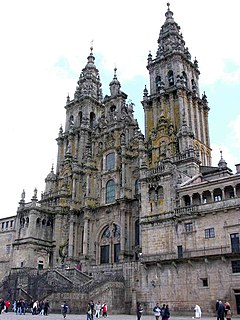
Churrigueresque, in a lesser extent it was also called "Ultra Baroque", refers to a Spanish Baroque style of elaborate sculptural architectural ornament which emerged as a manner of stucco decoration in Spain in the late 17th century and was used up to about 1750, marked by extreme, expressive and florid decorative detailing, normally found above the entrance on the main facade of a building.
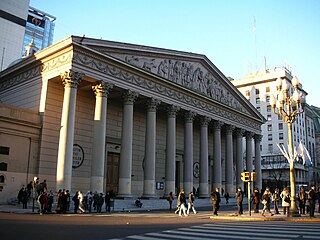
The Buenos Aires Metropolitan Cathedral is the main Catholic church in Buenos Aires, Argentina. It is located in the city center, overlooking Plaza de Mayo, on the corner of San Martín and Rivadavia streets, in the San Nicolás neighbourhood. It is the mother church of the Archdiocese of Buenos Aires and the primatial church of Argentina.

Spanish Baroque is a strand of Baroque architecture that evolved in Spain, its provinces, and former colonies.
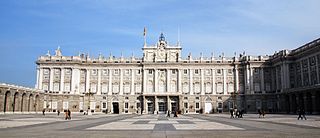
Spanish architecture refers to architecture in any area of what is now Spain, and by Spanish architects worldwide. The term includes buildings which were constructed within the current borders of Spain prior to its existence as a nation, when the land was called Iberia, Hispania, Al-Andalus or was divided between several Christian kingdoms. Drawing from many different sources, Spanish architecture demonstrates great historical and geographical diversity. Spanish architecture tended to develop along similar lines as other architectural styles around the Mediterranean and from Northern Europe.

Fascist architecture is an architectural style developed by architects of fascist states in the early 20th century. The style gained popularity in the late 1920s with the rise of modernism along with the ultranationalism associated with fascist governments in western Europe. The style resembles that of ancient Rome. However, the fascist-era buildings lack ostentatious design, and were constructed with symmetry and simplicity.
Events from the year 1665 in art.

José Benito de Churriguera was a Spanish architect, sculptor and urbanist of the late-Baroque or Rococo style. He was born in Madrid to a Catalan cabinetmaker, gilder and altarpiece joiner, Josep Simó Xoriguera i Elies and to doña Maria de Ocaña, and studied under his father along with two of his brothers.
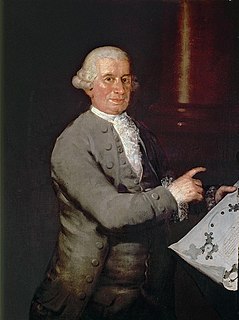
Ventura Rodríguez Tizón was a Spanish architect and artist. Born at Ciempozuelos, Rodríguez was the son of a bricklayer. In 1727, he collaborated with his father in the work at the Royal Palace of Aranjuez.
Events from the year 1725 in art.
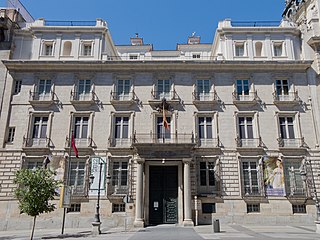
The Real Academia de Bellas Artes de San Fernando, located on the Calle de Alcalá in the heart of Madrid, currently functions as a museum and gallery.

Many of Mexico's older architectural structures, including entire sections of Pre-Hispanic and colonial cities, have been designated World Heritage sites for their historical and artistic significance. The country has the largest number of sites declared World Heritage Sites by UNESCO in the Americas.

Pedro de Ribera was a Spanish architect of the Baroque period.

The Palace of San Telmo is a historical edifice in Seville, southern Spain, formerly the Universidad de Mareantes, now is the seat of the presidency of the Andalusian Autonomous Government. Construction of the building began in 1682 outside the walls of the city, on property belonging to the Tribunal of the Holy Office, the institution responsible for the Spanish Inquisition. It was originally constructed as the seat of the University of Navigators, a school to educate orphaned children and train them as sailors.

The Convento de San Esteban is a Dominican monastery situated in the Plaza del Concilio de Trento in the city of Salamanca.

Pablo González Velázquez (1664–1727) was a Spanish Baroque sculptor.

The defunct Convento de Santo Tomás was a set of buildings belonging to the Dominicans, under the patronage of St. Thomas Aquinas, in Madrid.
References
- Pevsner, Fleming and Honour, The Penguin Dictionary of Architecture, Penguin Books, Middlesex, England, 1983
- Kelemen, Pal, Baroque and Rococo in Latin America, Dover Publications Inc., New York, volumes I and II, 1967